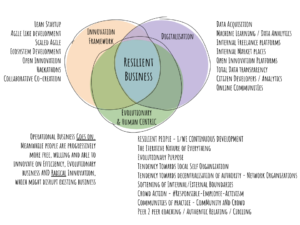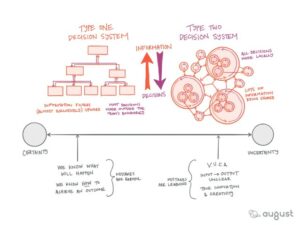This article has been written with my friend Max Bailey a few years ago following my experience as an employee.
WHY DO DISRUPTIVE CHANGE MAKING?
Do you believe that classical change methods within large companies are fast enough, or will deliver on the deep personal or collective changes that are required for real and sustainable change? All around it seems that there is talk of innovation, open innovation, intra/entrepreneurialism, agility, decentralisation of power, digitalisation, the VUCA world. And what of the human changes that need to go along all of this? Often labelled as simply a ‘mindset shift’ (and then quickly brushed over), this is surely the foundation for all of the above?
If we want our organisations to become more flexible, or rather, less rigid, then we must surely we need less rigid people? But why are some people perceived as inflexible anyway? Is it their beliefs, their behaviours? Their wish to avoid pain and pursue future happiness through the relative security of the known: their comfort zone?
It surely follows that to help people become more flexible, we must challenge the underlying belief systems and behaviours. Without this, will we change anything at all? Our conviction is that if we go deeply into this ‘mindset’ evolution, perhaps the hardest part of any transformation, then the rest will follow. The innovation, flexibility, decentralisation and evolutionary purpose will come as a by product: it will simply happen. But how to tackle deeply rooted belief systems and habitualised behavioural routines?
Disruptively of course… Disrupt normality and open the opportunity to go into something new. What follows is a tried and tested philosophy based on real experience at a global, large aerospace company headquartered in Europe.
What Kind Of Transformation Are We Talking About Here?
We are talking about the transformation into a resilient business fit for survival in a continuous state of environmental change; to be in a continuous state of transformation. We see this as mastering capabilities in three broad areas, as shown below, with the main success factor being the human aspects shown at the bottom. Without this aspect, the others are often limited by the old habitualised ways that people relate to one another.

How To Invite This Transformation At Personal And Organisational Level?
In order to unlock the organic transformation we seek at a personal and organizational level, we use a combination of ‘standard’ methods and ‘disruptive’ methods. Standard methods are well known in business transformation (e.g. they rely on awareness and deployment; normally from a top down mandate).
STANDARD METHODS
Standard change methods include:
- ‘As is’ and ‘to be’ Analysis
- Deployment Roadmap (linear planning)
- Nominated change agents
- Planned awareness & inspiration sessions with identified attendees and known speakers (normally top down)
- Top down workshops & facilitations sessions to support and sustain the change
- KPIs to monitor and control the state of the deployment
Disruptive Methods
This necessity to change seems to occur when people are faced with situations that are not comfortable (i.e. when people are out of the comfort zone).
We use disruptive methods that create instability and uncomfortable situations in order to invite :
- Individuals and groups to question their own normal habits, beliefs and behaviours
- Individuals and groups to question the validity of the existing systems, behaviours and beliefs. And to proactively disengage or stop complying with invalid or outdated systems
- Courage to practice in Authentically Relating to what is present in the experience of individuals and groups collectively. Telling the truth and hearing it without jumping to old defensive patterns
- Groups to collaborate in the creation new, emergent and continuously evolving systems, rituals and behaviours, and to start innovating at all levels.
- Embed deeply the spirit of continuous innovation and leadership in each individual
Ultimately this is about helping many people they have the right to act, and then giving them tools to take positive action in an inclusive way, and to handle the pain of letting go of the old ways through shared practices.
IN SUMMARY
we stimulate a conscious uncoupling from the existing systems, while simultaneously and collaboratively creating the new environment and behaviours, through disruptive crowd action, continuous open dialogue, relational practices change movement building and widespread empathy
WHAT ARE THE DISRUPTIVE METHODS?
As a high level overview, the following non-exhaustive list gives some examples of #Responsible-Employee-Activism:
- Movement building through online communities and online/offline events and meetups
- Grassroots awareness campaigns and co-creation about purpose, vision and future environment of the organization, including values, behaviours and practices?
- Visual campaigns using posters, stickers, graffiti (see examples in appendix)
- Thought provoking posts on social media (internal and public)
- Open letters to management at all levels of the business
- Petitions to senior management signed by many colleagues
- Peaceful mass gatherings of people to show solitude and the desire for change
- Developing unity amongst the people; focussing on our similarities, while welcoming differences. Development of widespread connection techniques such as circling.
- Nudge videos from the public domain, or from the internal
- Grassroots, open capturing a ‘shitlist’, or ‘backlog’, of things that could be improved in the company (local and company wide)
- Facilitating official and unofficial hackathons to propose solutions to ‘shitlist’ problems
- Invitation to consciously uncoupling from systems (e.g. no clocking on a given day)
- Unofficial events organized toshare experiences and stories, and to develop unity amongst the people – Development of online/offline communities of practice
#Responsible-Employee-Activism Examples
Examples of stickers used to invite discussion at a large and established industrial firm in Europe. These stickers were typically placed in toilets and entrances




